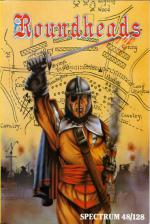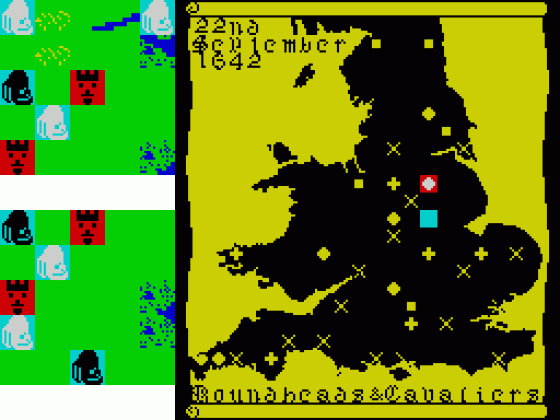
Crash
 1st October 1987
1st October 1987
Categories: Review: Software
Author: Philippa Irving
Publisher: Argus Press
Machine: Spectrum 48K
Published in Crash #45
Roundheads
This is the first wargame I've seen based on the English Civil War of the 1640's, which seems odd when you consider how popular a subject this is with 'live' wargamers; battles between the Roundheads and Cavaliers are re-enacted every summer by enthusiasts who delight to dress up in period military and fight it out in the name of a long-dead cause. Roundheads is an attempt to condense the entire period into a Spectrum.
In October 1642, the English Civil War broke out between the Cavalier forces of King Charles I and the parliamentary army led by the Earl Of Essex. My history is usually abysmal (an essential qualification for a wargame reviewer, for at least I can tell if a game has taught me anything…) but I do know that Oxford was the Royalist capital during the war and that King Charles lodged in Christchurch college.
All the major cities in England had been forced to choose sides, and the very brief scene-setting paragraph in the Roundheads rulebook says that as the game starts the Parliamentary forces - known as Roundheads - have their greatest support in the south and east. They are also negotiating for Scottish support, which they appear to get. Up and down the country peasants have been turning their pitchforks into weapons, leaving their fields, and rallying behind one cause or the other. This has not done much for the country's agricultural stability, and food supplies are restricted to what the passing troops can forage.
Roundheads ambitiously attempts to recreate the entire war at both tactical and strategic levels. You can move whole armies up and down the country cutting down cornfields on the way; or you can fight single battles with small forces. The two phases of the game demonstrate how different reality scales affect wargaming, and it's interesting to see a combination of the grand and the detailed. This feature distinguishes an otherwise unremarkable game.
On the strategic level, the screen presents a map of England which is featureless apart from the noughts and crosses of the opposing armies. In the one-player game you have to be on the side of the King, which gives you a slight advantage at first; the Cavalier armies are better-trained and slightly stronger than the Roundheads. But the Scots soon come marching south to aid the enemy, so the rules advise the player to make the most of his superiority.
Incidentally, the lack of choice of sides in the one-player game makes the title Roundheads seem a little inappropriate, and because Roundheads And Cavaliers appears on the bottom of the screen I suspect there was a last minute title change.
The player has command of two types of armies at the strategic level; real armies and 'trained bands'. These latter Consist of the peasants-turned-warriors and other loyal or rebellious citizens from the towns, rounded up into some sort of fighting force. They can be used in battle, but they're not particularly reliable and tend to desert if they're moved too far from home or think the odds against them are too great.
The rulebook illustrates what the Roundhead armies and trained bands look like, but neglect to make the distinction between their Royalist equivalents. One has to guess. My guess was that the large round blobs were the armies, and the smaller squares the trained bands. Confusingly, the instructions refer to the units as 'icons'. This may be a strictly correct use of the word, but it's certainly incorrect in the context of a computer game where 'icon' is always used to mean a control symbol. Here, the control system is a simple cursor-selection, which allows the player to move armies speedily. As the armies move they gather food points, which doesn't make sense; after all, wargamers are more accustomed to armies consuming food and resource points by moving. A food riot can therefore be quelled by sending the troops on a quick back-and-forth trip across the countryside.
As the cursor is moved around the main map a window at the side of the screen scrolls neatly, showing a blow-up of the area currently under the cursor. The side window also displays more attractive versions of the army counters, with the Royalist army represented as crowned heads and the Roundheads looking like genially smiling grandfathers. This seems more useful than it is.
The close-up map doesn't actually show any extra detail apart from mysterious little houses, invisible on the main map, which may be intended to indicate cities. It's difficult to tell, for the rules make no mention of them. There is no way of telling which towns and cities are where, something I regard as very unatmospheric. If there was no room on the screen display there ought to have been a map in the rules to give a bit of colour and structure to the landscape...
The armies and trained bands are defined only by their strength and the amount of food they carry. It would have improved the coherence of the game immensely if the armies had been identified, even in the most rudimentary way. As it is, there is nothing to give them character and imaginative life, and even if dire consequences do follow moving a trained band too far from its place of origin it's not easy to keep track of where each bunch of pickaxe-waving peasants ought to be.
This is a pity, because in the tactical-level battles there's a great opportunity to tie the two strands together. When you've moved your armies around an isolated, defenceless enemy unit you can choose to enter the tactical level, and the screen display changes entirely to show a battlefield. This, quite cleverly, bears a clear relationship to the landscape on the main map; though the scale is quite wrong, for you find yourself battling all the way across the westernmost tip of Cornwall. The combat is grandly entitled the Battle Of York, or the Battle Of London, or the Battle of wherever you've decided to bash a few Roundheads. That's a fine touch, but it's offset by more basic deficiencies of detail.
Though the strategic-level display is reasonably polished, the battlefield is a masterpiece of primitive-style Spectrum and looks like it's been drawn in crayon. The background is a glaring blank, the infantry units are matchstick men, and the four terrain types are represented very simplistically. It is, unfortunately, strongly reminiscent of those extremely early Spectrum games like Horace Goes Skiing.
The number of red matchstick men the player finds opposing the Roundhead blue matchstick men is related to the strength and number of armies he had ranged against the enemy in the map on the strategic level, and there's something curiously satisfying about this. According to the rules the units are distributed randomly, though they always start out in clusters of their own kind.
Infantry, cavalry and artillery make up the fighting force, with the unexpected addition of supply wagons. I assume that the supply wagons are intended to represent the army's food stock - that vital statistic displayed in the strategic map - but I see no reason why they should be taken onto the battlefield, unless the troops are supposed to refresh themselves with sandwiches and cups of tea during slack phases in the fighting. Really, they're there to provide something vulnerable to attack and defend, and if you see that you' re hopelessly outnumbered it's a good idea to make straight for the enemy's food wagons and destroy as many of them as you can before you get wiped out.
Orders are given to individual units with a cursor, in an unsophisticated fashion. It is difficult to extract from the rules a clear understanding of how the combat really works. It seems you can give each unit a single order to attack and then watch as it carries out the order, following the target if it moves.
This doesn't seem to work in practice. I found the only sure way to make an attack was to specify each one individually, and because this is a game played in real time the old problems arise: you can only deal with one unit at one time. To be fair, the number of units involved are small enough to be manageable, though this style of frantic, cursor-hopping play - does destroy the atmosphere. As each attack is made, the 'before and after' strength of each unit is flashed at the bottom of the screen.
Strength units tend to be chipped off at the rate of one per unit, with only minor and not very predictable variations. Even artillery units firing at long range lose a strength point when they make an attack, and this seems illogical to me. I was disconcerted to discover that my food wagons made pretty invincible fighting machines when I tried to attack with them; either the rock buns are pretty old, or there's a bug in the program. The enemy's food wagons are easy to destroy.
There is some variety in the play of the battle scenes. The 'defensible area' type of terrain allows infantry to shelter from attack, and though the woods and hills seem to have no effect on combat it's impossible to move across rivers. And, like all simplistic games, Roundheads has a degree of tacky addictiveness.
The battle lasts as long as it takes for one side to eliminate the other, or till you choose to exit from it. The instructions claim that you can only do this after 15 minutes, but this is incorrect; maybe it's a misprint for '5 minutes'. When you're returned to the strategic screen the appropriate army counter has disappeared and the attacking forces are depleted according to the losses suffered. This is where I feel a sense of involvement could be generated by giving the units names, names carried over to the individual divisions in the battle scenes. It would be satisfying to know which divisions belong to which army, which are trained soldiers and which are volunteer rabble. The distinction vanishes into anonymity at the tactical level.
There are several irritating points of presentation. The rules are vague and confusing. The instructions on giving orders are ambiguous, the Cavalier unit symbols aren't shown, and there's no warning that the game has to be reloaded if you want to start again. The game is artificially slowed down by the rule which insists that three minutes must separate each entry to tactical battle, a restraint which seems to be designed to make the two-player game fairer. In the one-player version it's simply irritating. Roundheads isn't as bad as it looks; I enjoyed it up to a point, and see the potential of some of the things it tries to do. But there's a lack of detail, depth, atmosphere and - somehow - solidity, deficiencies which are all too common in Spectrum wargames.
Other Reviews Of Roundheads For The Spectrum 48K
Roundheads (Lothlorien)
A review by Owen Bishop, Audrey Bishop (Your Sinclair)
Other Spectrum 48K Game Reviews By Philippa Irving
Scores
Spectrum 48K Version| Presentation | 70% |
| Rules | 50% |
| Playability | 70% |
| Graphics | 60% |
| Authenticity | 55% |
| Overall | 59% |












